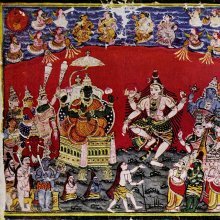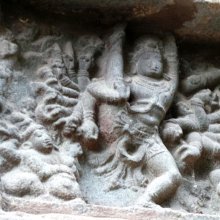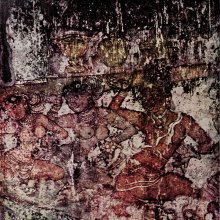Tandava, Tāṇḍava, Tamdava: 20 definitions
Introduction:
Tandava means something in Buddhism, Pali, Hinduism, Sanskrit, the history of ancient India, Marathi, Jainism, Prakrit. If you want to know the exact meaning, history, etymology or English translation of this term then check out the descriptions on this page. Add your comment or reference to a book if you want to contribute to this summary article.
Images (photo gallery)
In Hinduism
Natyashastra (theatrics and dramaturgy)
Source: Wisdom Library: Nāṭya-śāstraTāṇḍava (ताण्डव) refers to “class dance” and was created by Taṇḍu after receiving instructions from Śiva, according to the Nāṭyaśāstra chapter 4. Accordingly, “after inventing the Recakas, Aṅgahāras and Piṇḍīs, Śiva communicated them to the sage Taṇḍu who in his turn made out of them dance together with songs and instrumental music; and hence this dance is known as tāṇḍava (i.e. of Taṇḍu’s creation).... The Class Dance (tāṇḍava) is mostly to accompany the adoration of gods, but its gentler form (sukumāra-prayoga) relates to the erotic sentiment”.
Source: Shodhganga: The significance of the mūla-beras (natya)Tāṇḍava refers to “dance with jumping/leaping movements” is explained in the Tāṇḍava-tāla-marapu, the second part of the Niruttamarapu (“literary usage of dance”) which represents the third book of the Pañcamarapu (‘five-fold traditional usage’): an important piece of Tamil literature.—The sixteen types of tāṇḍava that were danced by Śiva and Kālī in a place called Ālankāṭu are said to have expressed the characters and navarasas of akam in their dance and this aspect is known as akamarga (exposition by gesture and dancing of the three characters, namely sattva (yogic), rajas (majestic) and tāmas (powerful and aggressive).

Natyashastra (नाट्यशास्त्र, nāṭyaśāstra) refers to both the ancient Indian tradition (shastra) of performing arts, (natya—theatrics, drama, dance, music), as well as the name of a Sanskrit work dealing with these subjects. It also teaches the rules for composing Dramatic plays (nataka), construction and performance of Theater, and Poetic works (kavya).
Purana and Itihasa (epic history)
Source: Shodhganga: The saurapurana - a critical studyTāṇḍava (ताण्डव) refers to the dance of Lord Kālāgni-Rurdra appearing at the time of Prākṛta-Pralaya (“dissolution at the end of the span of life of Brahmā”), according to the 10th century Saurapurāṇa: one of the various Upapurāṇas depicting Śaivism.—Prakṛta-pralaya occurs when the span of life of Brahmā is over. The span of life of Brahmā continues for two parārdhas. At the end of the two parārdhas Lord Kālāgni-Rurdra having burnt the Universe resorts to Tāṇḍava-dance. Then the earth with its qualities merge in water, water in turn merges in Agni, Agni merges in vāyu while vāyu merges in ākāśa. [...]

The Purana (पुराण, purāṇas) refers to Sanskrit literature preserving ancient India’s vast cultural history, including historical legends, religious ceremonies, various arts and sciences. The eighteen mahapuranas total over 400,000 shlokas (metrical couplets) and date to at least several centuries BCE.
Sports, Arts and Entertainment (wordly enjoyments)
Source: archive.org: Syainika Sastra of Rudradeva with English Translation (art)1) Tāṇḍava (ताण्डव) refers to the “wild style of dancing”, according to the Śyainika-śāstra: a Sanskrit treatise dealing with the divisions and benefits of Hunting and Hawking, written by Rājā Rudradeva (or Candradeva) in possibly the 13th century.—Accordingly, “[...] It has been said that there are eighteen addictions. These are the outcome of the desire for earthly enjovments. [...] Dancing is of two kinds—the wild, called tāṇḍava, and the theatrical, called lāsya. It is accompanied with chārī or amorous gait and laya or keeping time. [...]”.
2) Tāṇḍava (ताण्डव) refers to the “wild dance (of the peacocks)” (in the rainy season), according to the Śyainika-śāstra.—Accordingly, [while discussing the treatment of hawks]: “[...] In the rainy season, when the clouds thunder, when the sky is lighted up with the flash of lightning, when the fragrance of the Mālatī flower delights all creatures, when the frogs croak and the peacocks dance wildly (tāṇḍava) [śikhaṇḍikṛtatāṇḍave], [...] These birds should be tended in such a way that regaining their vigour they may cast off their old feathers and assume new ones just as snakes assume a new slough. [...]”.

This section covers the skills and profiencies of the Kalas (“performing arts”) and Shastras (“sciences”) involving ancient Indian traditions of sports, games, arts, entertainment, love-making and other means of wordly enjoyments. Traditionally these topics were dealt with in Sanskrit treatises explaing the philosophy and the justification of enjoying the pleasures of the senses.
General definition (in Hinduism)
Source: WikiPedia: HinduismTandava (ताण्डव): Siva's cosmic dance.
In Buddhism
Tibetan Buddhism (Vajrayana or tantric Buddhism)
Source: OSU Press: Cakrasamvara SamadhiTāṇḍava (ताण्डव) refers to “ dancing”, according to the Cakrasaṃvara Samādhi [i.e., Cakrasamvara Meditation] ritual often performed in combination with the Cakrasaṃvara Samādhi, which refers to the primary pūjā and sādhanā practice of Newah Mahāyāna-Vajrayāna Buddhists in Nepal.—Accordingly, “Dark, smokey and gray colored, in constant celebration, always dancing (sadā-tāṇḍava). Emptiness and compassion themselves, manifesting in the three worlds, The flaming bright fire at the end of a kalpa, homage to you Vajrayoginī”.
Source: MDPI Books: The Ocean of HeroesTāṇḍava (ताण्डव) refers to “dancing”, according to the 10th-century Ḍākārṇava-tantra: one of the last Tibetan Tantric scriptures belonging to the Buddhist Saṃvara tradition consisting of 51 chapters.—Accordingly, “[...] [Standing on] Bhairava and Kālarātri on fire on the sun [disk] on the pericarp [of the lotus], [Heruka] is dancing (tāṇḍava). [He should visualize Heruka] having the body [colored] half black and half green; [complete with] seventy-six arms; [having] seventeen [faces] with three eyes [on each]; wearing a crown of twisted locks of hair; being a hero; [having] a crossed vajra [on top of the head] and a half moon [on the head]; [...]”.

Tibetan Buddhism includes schools such as Nyingma, Kadampa, Kagyu and Gelug. Their primary canon of literature is divided in two broad categories: The Kangyur, which consists of Buddha’s words, and the Tengyur, which includes commentaries from various sources. Esotericism and tantra techniques (vajrayāna) are collected indepently.
India history and geography
Source: Cologne Digital Sanskrit Dictionaries: Indian Epigraphical GlossaryTāṇḍava.—(CII 4), name of the dance of Śiva. Note: tāṇḍava is defined in the “Indian epigraphical glossary” as it can be found on ancient inscriptions commonly written in Sanskrit, Prakrit or Dravidian languages.

The history of India traces the identification of countries, villages, towns and other regions of India, as well as mythology, zoology, royal dynasties, rulers, tribes, local festivities and traditions and regional languages. Ancient India enjoyed religious freedom and encourages the path of Dharma, a concept common to Buddhism, Hinduism, and Jainism.
Languages of India and abroad
Marathi-English dictionary
Source: DDSA: The Molesworth Marathi and English Dictionarytāṇḍava (तांडव).—n (S) Dancing with violent gesticulation: (as that of Shiva and his votaries.) 2 Exaggeration; aggravating and harping upon; wild dancing about, or great cry and fuss upon, a little matter; storming and stamping. 3 Amplification or embellishing diffusion (as of a text or a tale.)
Source: DDSA: The Aryabhusan school dictionary, Marathi-Englishtāṇḍava (तांडव).—n Dancing with violent gesticula- tion. Exaggeration.
Marathi is an Indo-European language having over 70 million native speakers people in (predominantly) Maharashtra India. Marathi, like many other Indo-Aryan languages, evolved from early forms of Prakrit, which itself is a subset of Sanskrit, one of the most ancient languages of the world.
Sanskrit dictionary
Source: Cologne Digital Sanskrit Dictionaries: Shabda-Sagara Sanskrit-English DictionaryTāṇḍava (ताण्डव).—mn.
(-vaḥ-vaṃ) 1. Dancing, especially with violent gesticulation, and particularly applied to the frantic dance of the god Siva, and his votaries. 2. A sort of grass, (Saccharum procerum.) m.
(-vaḥ) In prosody, a tribrach or foot of three sort syllables. E. taṇḍu the name of the Muni, by whom the style of dancing was first taught, affix aṇ, or taḍi to beat, and ava aff.
Source: Cologne Digital Sanskrit Dictionaries: Benfey Sanskrit-English DictionaryTāṇḍava (ताण्डव).—m. and n. Frantic dancing, [Caurapañcāśikā] 7; Rājan. 5, 380.
Source: Cologne Digital Sanskrit Dictionaries: Cappeller Sanskrit-English DictionaryTāṇḍava (ताण्डव).—[substantive] a wild dance, [especially] of the god Śiva.
Source: Cologne Digital Sanskrit Dictionaries: Monier-Williams Sanskrit-English Dictionary1) Tāṇḍava (ताण्डव):—[from tāṇḍa] mn. ([gana] ardharcādi; [from] taṇḍu?) dancing ([especially] with violent gesticulation), frantic dance (of Śiva and his votaries), [Mālatīmādhava; Kathāsaritsāgara; Bhāgavata-purāṇa x; Matsya-purāṇa; Rājataraṅgiṇī] etc. (cf. [Religious Thought and Life in India p.84])
2) [v.s. ...] (in prosody) a tribrach
3) [v.s. ...] Saccharum procerum, [cf. Lexicographers, esp. such as amarasiṃha, halāyudha, hemacandra, etc.]
Source: Cologne Digital Sanskrit Dictionaries: Yates Sanskrit-English DictionaryTāṇḍava (ताण्डव):—[(vaḥ-vaṃ)] 1. m. n. Dancing especially with violent gesticulation; a grass. m. A tribrach.
Source: DDSA: Paia-sadda-mahannavo; a comprehensive Prakrit Hindi dictionary (S)Tāṇḍava (ताण्डव) in the Sanskrit language is related to the Prakrit words: Taṃḍava, Taṃuva.
[Sanskrit to German]
Sanskrit, also spelled संस्कृतम् (saṃskṛtam), is an ancient language of India commonly seen as the grandmother of the Indo-European language family (even English!). Closely allied with Prakrit and Pali, Sanskrit is more exhaustive in both grammar and terms and has the most extensive collection of literature in the world, greatly surpassing its sister-languages Greek and Latin.
Prakrit-English dictionary
Source: DDSA: Paia-sadda-mahannavo; a comprehensive Prakrit Hindi dictionaryTaṃḍava (तंडव) in the Prakrit language is related to the Sanskrit word: Tāṇḍava.
Prakrit is an ancient language closely associated with both Pali and Sanskrit. Jain literature is often composed in this language or sub-dialects, such as the Agamas and their commentaries which are written in Ardhamagadhi and Maharashtri Prakrit. The earliest extant texts can be dated to as early as the 4th century BCE although core portions might be older.
Kannada-English dictionary
Source: Alar: Kannada-English corpusTāṃḍava (ತಾಂಡವ):—
1) [noun] the dance of Śiva characterised by the forceful action, manly vigour, destructive power, etc.
2) [noun] (dance.) any dance performance exhibiting these characters.
3) [noun] (fig.) any uncontrollable and extreme disaster (as a natural calamity, an unabated act of terrorists, etc.) that results in great loss and grief.
Kannada is a Dravidian language (as opposed to the Indo-European language family) mainly spoken in the southwestern region of India.
See also (Relevant definitions)
Starts with: Tamdavadu, Tamdavagai, Tamdavala, Tamdavavadu, Tandava kaviraja, Tandavabrahmana, Tandavam, Tandavanritya, Tandavapriya, Tandavaroga, Tandavasana, Tandavastotra, Tandavatalika, Tandavatanda, Tandavayitar, Tandavayitri.
Ends with: Abhinavatarkatandava, Akandatandava, Anandatandava, Kavitandava, Kekitamdava, Shabdatandava, Shikhamditamdava, Shivatandava, Tarkatandava, Urdhvatandava, Vivadatandava.
Full-text (+40): Tandavapriya, Tandavatalika, Tandavita, Tandu, Tandavanritya, Nritya, Shivatandavastotra, Lasya, Tamdava, Tamuva, Tamdavavadu, Shabdatandava, Tandava kaviraja, Vivadatandava, Tandav, Suktyadarsha, Nataraja, Lilatandavapandita, Akandatandava, Tantavan.
Relevant text
Search found 43 books and stories containing Tandava, Tāṇḍava, Tamdava, Taṃḍava, Taṇḍava, Tāṃḍava; (plurals include: Tandavas, Tāṇḍavas, Tamdavas, Taṃḍavas, Taṇḍavas, Tāṃḍavas). You can also click to the full overview containing English textual excerpts. Below are direct links for the most relevant articles:
Gati in Theory and Practice (by Dr. Sujatha Mohan)
Description of Gati as in Bharatārṇava < [Chapter 2 - Concept and technique of Gati]
Enactment of gati with Cārīs and Karaṇas < [Chapter 2 - Concept and technique of Gati]
Technical treatises on Nāṭya (other works) < [Chapter 1 - Nāṭya]
Amarakoshodghatana of Kshirasvamin (study) (by A. Yamuna Devi)
Three types of Dance < [Chapter 4 - Cultural Aspects]
The Linga Purana (by J. L. Shastri)
Chapter 106 - Tāṇḍava dance of Śiva < [Section 1 - Uttarabhāga]
Chapter 55 - The Sun’s Chariot (sūryaratha) < [Section 1 - Uttarabhāga]
Chapter 82 - Hymn of purification (vyapohana-stava) < [Section 1 - Uttarabhāga]
The Religion and Philosophy of Tevaram (Thevaram) (by M. A. Dorai Rangaswamy)
Chapter 4.3 - (a) Nataraja (the dance of Shiva) < [Volume 2 - Nampi Arurar and Mythology]
Chapter 4.3 - (b) The seven Tandava Dances of Shiva < [Volume 2 - Nampi Arurar and Mythology]
Chapter 4.6 - (m) Symbology of Fire < [Volume 2 - Nampi Arurar and Mythology]
Bhakti-rasamrta-sindhu (by Śrīla Rūpa Gosvāmī)
Verse 1.2.156 < [Part 2 - Devotional Service in Practice (sādhana-bhakti)]
Verse 4.9.34 < [Part 9 - Incomplete Expression of Mellows (rasābhāsa)]
Verse 1.2.127 < [Part 2 - Devotional Service in Practice (sādhana-bhakti)]
Early Chola Temples (by S. R. Balasubrahmanyam)
Bronze, group 2: Age of Aditya I (a.d. 871-907) < [Chapter XI - Sculpture]
Muktesvaram < [Chapter XIV - Conclusion]
Temples in Pullamangai (near Pasupatikoyil) (3rd to 6th year) < [Chapter X - Historical Survey]



